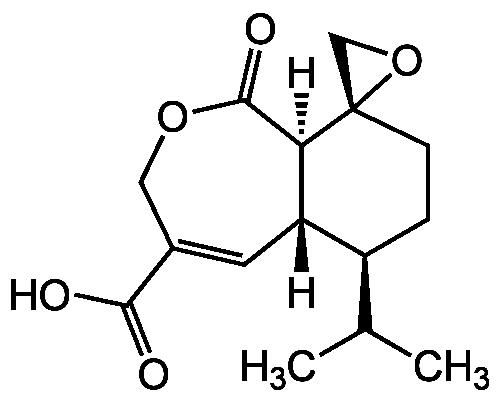Heptelidic acid
Product Code: AG-CN2-0118
Product Group: Natural Products and Extracts
Supplier: AdipoGen Life Sciences
| Code | Size | Price |
|---|
| AG-CN2-0118-C250 | 250 ug | £110.00 |
Quantity:
| AG-CN2-0118-M001 | 1 mg | £330.00 |
Quantity:
Prices exclude any Taxes / VAT
Overview
Regulatory Status: RUO
Shipping:
Ambient
Storage:
-20°C
Images
Documents
Further Information
Alternate Names/Synonyms:
Koningic acid; Avocettin; FO-4443; BRN 5091359; HPA
Appearance:
White solid.
CAS:
57710-57-3 (74310-84-2 deleted)
EClass:
32160000
Form (Short):
liquid
GHS Symbol:
GHS07
Handling Advice:
Ke
Hazards:
H302, H312, H332
InChi:
InChI=1S/C15H20O5/c1-8(2)10-3-4-15(7-20-15)12-11(10)5-9(13(16)17)6-19-14(12)18/h5,8,10-12H,3-4,6-7H2,1-2H3,(H,16,17)/t10-,11-,12-,15-/m1/s1
InChiKey:
JESMSCGUTIEROV-RTWAVKEYSA-N
Long Description:
Chemical. CAS: 57710-57-3 (74310-84-2 deleted). Formula: C15H20O5. MW: 280.3. Isolated from Trichoderma sp. Antibiotic. Potent selective glyceraldehyde 3-phosphate dehydrogenase (GAPDH) inhibitor. Binds to the essential Cys149 residue in the catalytic site of GADPH. Anticancer compound. Selectively kills high-glycolytic cancer cells through glucose-dependent active ATP deprivation. Antimalarial. Apoptosis inhibitor. DNA fragmentation and caspase-3 activation inhibitor. Selective and competitive inhibitor of mammalian DNA polymerases beta, lambda and terminal deoxynucleotidyl transferase (TdT) in family X of pols.
MDL:
MFCD01684016
Molecular Formula:
C15H20O5
Molecular Weight:
280.3
Package Type:
Vial
Precautions:
P261, P301, P312, P302, P352, P304, P340
Product Description:
Antibiotic [1, 2]. Potent selective glyceraldehyde 3-phosphate dehydrogenase (GAPDH) inhibitor. Binds to the essential Cys149 residue in the catalytic site of GAPDH [3-7, 10, 11]. Anticancer compound [8]. Selectively kills high-glycolytic cancer cells through glucose-dependent active ATP deprivation [12]. Antimalarial [9]. Apoptosis inhibitor. DNA fragmentation and caspase-3 activation inhibitor [13,16]. Selective and competitive inhibitor of mammalian DNA polymerases beta, lambda and terminal deoxynucleotidyl transferase (TdT) in family X of pols [14]. Reduces lactate secretion and causes reductions in overall protein synthesis and production of IFN-alpha and TNF.
Purity:
>95% (HPLC)
Signal word:
Warning
SMILES:
[H][C@@]12C=C(COC(=O)[C@@]1([H])[C@@]1(CO1)CC[C@H]2C(C)C)C(O)=O
Solubility Chemicals:
Soluble in DMSO (10mg/ml), ethanol (1mg/ml), methanol (1mg/ml) or water (1mg/ml).
Source / Host:
Isolated from Trichoderma sp.
Transportation:
Non-hazardous
UNSPSC Category:
Natural Products/Extracts
UNSPSC Number:
12352200
Use & Stability:
Stable for at least 3 years after receipt when stored at -20°C.
References
A new sesquiterpene antibiotic, heptelidic acid producing organisms, fermentation, isolation and characterization: Y. Itoh, et al.; J. Antibiot. (Tokyo) 33, 468 (1980) | Structure of heptelidic acid, a new sesquiterpene antibiotic from fungi: Y. Itoh, et al.; J. Antibiot. (Tokyo) 33, 525 (1980) | Specific inhibition of glyceraldehyde-3-phosphate dehydrogenase by koningic acid (heptelidic acid): A. Endo, et al.; J. Antibiot. (Tokyo) 38, 920 (1985) | Inactivation of rabbit muscle glyceraldehyde-3-phosphate dehydrogenase by koningic acid: K. Sakai, et al.; Biochim. Biophys. Acta 952, 297 (1988) | Identification of koningic acid (heptelidic acid)-modified site in rabbit muscle glyceraldehyde-3-phosphate dehydrogenase: K. Sakai, et al.; Biochim. Biophys. Acta 1077, 192 (1991) | Koningic acid (heptelidic acid) inhibition of glyceraldehyde-3-phosphate dehydrogenases from various sources: M. Kato, et al.; Biochim. Biophys. Acta 1120, 113 (1992) | Glyceraldehyde-3-phosphate dehydrogenase is required for the transport of nitric oxide in platelets: B. McDonald, et al.; PNAS 90, 11122 (1993) | Antitumor activity of heptelidic acid chlorohydrin: J. Kawashima, et al.; J. Antibiot. (Tokyo) 47, 1562 (1994) | Antimalarial activity of radicicol, heptelidic acid and other fungal metabolites: Y. Tanaka, et al.; J. Antibiot. (Tokyo) 51, 153 (1998) | Glyceraldehyde-3-phosphate dehydrogenase activity as an independent modifier of methylglyoxal levels in diabetes: P.J. Beisswenger, et al.; Biochim. Biophys. Acta 1637, 98 (2003) | D-Glyceraldehyde causes production of intracellular peroxide in pancreatic islets, oxidative stress, and defective beta cell function via non-mitochondrial pathways: H. Takahashi, et al.; J. Biol. Chem. 279, 37316 (2004) | Glucose-dependent active ATP depletion by koningic acid kills high-glycolytic cells: S. Kumagai, et al.; BBRC 365, 362 (2008) | Heptelidic acid, a sesquiterpene lactone, inhibits Etoposide-induced apoptosis in human leukemia U937 cells: J.H. Kim & C.H. Lee; J. Microbiol. Biotechnol. 19, 787 (2009) | Novel terpenoids, trichoderonic acids A and B isolated from Trichoderma virens, are selective inhibitors of family X DNA polymerases: Y. Yamaguchi, et al.; Biosci. Biotechnol. Biochem. 74, 793 (2010) | Rapid effector function of memory CD8+ T cells requires an immediate-early glycolytic switch: P. M. Gubser, et al.; Nat. Immunol. 14, 1064 (2013) | The immune-metabolic basis of effector memory CD4+ T cell function under hypoxic conditions: S. Dimeloe, et al.; J. Immunol. 196, 106 (2016) | ATP produced by anaerobic glycolysis is essential for enucleation of human erythroblasts: T. Goto, et al.; Exp. Hematol. 72, 14 (2019) | Probiotic Aspergillus oryzae produces anti-tumor mediator and exerts anti-tumor effects in pancreatic cancer through the p38 MAPK signaling pathway: H. Konishi, et al.; Nat. Sci. Rep. 11, 11070 (2021) | Plasmacytoid dendritic cell activation is dependent on coordinated expression of distinct amino acid transporters: K.M. Grzes, et al.; Immunity 54, 2514 (2021)



